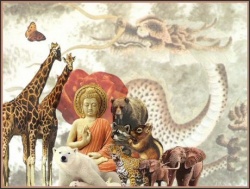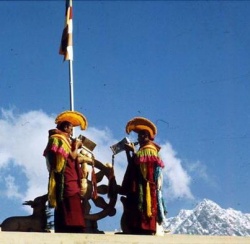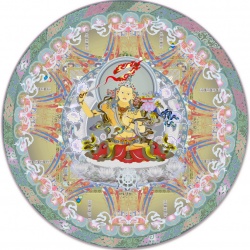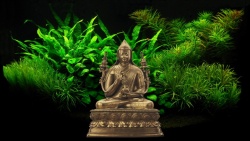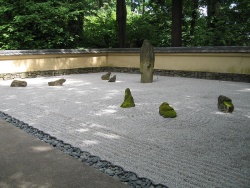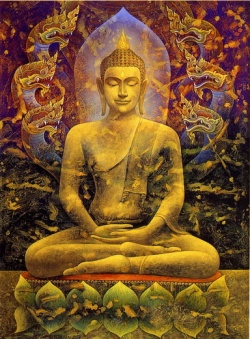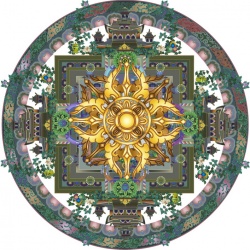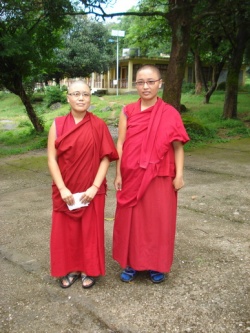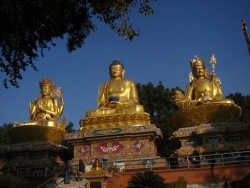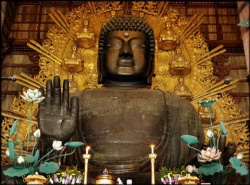Kundalini and candali-yoga
There are three topics for Candali. They are the preliminaries, the main practice, and the enhancement. In preliminary part, there are five subtopics: the outer physical form, the inner form of the nadis, the “wheel of protection”, training in the path of the nadis, and blessing of the nadis’ points.
The first practice is Guru Yoga. Dissolve the guru into oneself. Visualize oneself as the Ishta-devata in standing position. Purify the discursive thoughts of Samsara. The purifying antidote is the meditation with complete qualities. The fruit of purification is the maturation of appearance, sound and cognition as the essence of the Vajra. This is the ultimate intent of anuttaraguhyamantra (unsurpassable secret mantra)[1].
Omniscient Jigme Lingpa[2] says, "Ho: All appearances and existence are a pure dakini land Unchanging great bliss is Vajrayogini Ultimate Vajrayogini is perfect in all aspects May I attain enlightenment by meeting (my?) own face ". It is like this.
For the outer physical form, one's body is like Vajrayogini, which is radiant (370). With stable divine pride, the visualization is like a rainbow, which is apparent yet lacks inherent existence. Don't think of it as solid. You should visualize the (outer physical form) as one’s own size, or the size of a house, or the size of the three worlds. You should (also) train in visualization down to size of sesame seed.
For the inner form of the nadi; the color is light red, which denotes great bliss. It is like butter lamp of mustard-seed oil because it dispels obscurations. It is straight like a plantain trunk, which denotes the life force of all phenomena. It is hollow like a tube, which denotes its’ empty essence. It is the thickness of a medium sized arrow shaft. This is the visualization at the time of Candali practice.
When you are practicing transference of consciousness[3], it is dark blue to denote unchanging Dharmakaya. It is thin like the petal of a lotus to denote the lessening of obscurations. It is clear like a butter lamp of mustard-seed oil to denote dispelling the darkness of ignorance. It is straight like plantain trunk to denote closing of the lower and wrong paths. These are the special qualities of the nadi.
If the visualization is not clear, apply the methods. (371). If you cannot hold the vayus, apply the methods. If the mind is not concentrated, apply them.
Third, the “wheel of protection”. Sitting in Vairocana's sevenfold posture is the “main point” of the body. First exhale slowly, then with medium force, and finally exhale forcefully. Exhale nine times. Hold the breath by pressing down the upper vayu and holding (up?) the downward vayu. You should practice for as long as you can hold it. This is “main point” of breathing.
Visualize oneself as Vajravarahi. Exhale three times while thinking of the expulsion of the three poisons. Then hold the kumbhaka-breath once. When you exhale, five-colored light issues forth from the sense organs and the pores of body. The entire world is filled with five-colored light. When you inhale, it enters from all the orifices of body and fills the whole body. Repeat this seven times.
The light changes into a five-colored letter 'Hung'. When exhaling, the whole universe is filled. When inhaling, the whole body is filled. Repeat this visualization seven times. Again, the letter Hung changes into multicolored light and goes out and comes back.[4] Repeat it seven times. You should maintain the divine pride of the Buddha's body, voice and mind (372). Finally, all the pores of the body are filled with great wrathful deities. Visualize yourself as a wrathful Buddha who is inside a blazing fire. This is the meditation on the “wheel of protection”.
Fourth, training in the path of nadis. The “Main point” of body is the deity visualization as before. There is the central nadi in the body from the top of head to secret place. It is standing like a pillar. There are the left the right nadis on either side of it. From the upper membrane of the brain to the nostril, there are 16 red vowels like A, AA. and so forth, in the left nadi, and 35 white colored consonants like ka, kha, ga, gha, nga and so forth in the right nadi.[5] You should visualize them as piled up on top of one another.
You should breath in the previous way. Then hold the kumbhaka and concentrate the mind in the reality of vowels and consonants when exhaling. The letters come out equally and continuously. While inhaling, meditate on vowels and consonants. Otherwise, while inhaling, they enter from the secret nostril(?) and rotate like a firebrand[6]. Repeat this 21 times. For the vayu to enter into the central nadi, you need (to train) the paths of the left and right nadis (373). It is very important to train it in an unobstructed way. It helps to increase profound wisdom, it increases the length of the life span, and power (strength?). This is the profound root visualization for the accomplishment of innumerable good qualities.
Fifth, blessing of the nadis’ points. In the state of deity’s form having the three nadis and four chakras or a single central nadi, you should visualize your root guru at heart level. He is in the form of Uddiyana Vajradhara, in union with his consort, on a lotus, sun and moon. On his crown are the gurus of the six lineages. On the top, you should visualize the Dharmakaya Samantabhadra in union with his consort. He is residing in the center of a mass of wisdom-rainbow-light.
You should pray from the bottom of your heart. Finally Samantabhadra and Samantabhadri dissolve into light and absorb into Garab Dorje. He dissolves into light and is absorbed into Manjushrimitra and so on. Finally, they dissolve into your root guru. He is also dissolved into light and becomes a reddish white bindu having the nature of uncontaminated great bliss. It pervades all parts of the nadis and transforms them into the Mahamudra of bliss and emptiness.
The extensive practice is doing kumbhaka seven times with each supplication and dissolution. The medium length practice is performing kumbhaka breathing five times with each supplication and dissolution. When you perform kumbhaka breathing three times, it is the condensed practice
Second Topics: the main practice of Candali
It has three subtopics (which are), the “main point” of body, the “main point” of the vayus, and “main points” of visualization.
First, you should sit in seven-fold Vairocana posture or (that of the six-cornered stove). You need a genuine meditation belt and a large seat of four fingers height for jumping
For “main point” of the vayus, you should perform the nine-fold breathing as a preliminary. For main practice, there are four applications. Among them, the body must be in the previously mentioned posture. From right nostril, you should inhale slowly without others feeling it(?), when it reaches and presses the navel vayu, you should exhale slowly from left nostril. Similarly, inhale from left and exhale from right. Inhale equally and exhale equally (through both). Then, inhale and exhale forcefully.
Then inhale from the right in previous posture, in accordance with turning(?) lean and exhale from the left or you can inhale turning to left side (375) and exhale far to the right. Or you can inhale and exhale equally while drawing the shoulder backward. On these occasions, the vayus causing five disturbing emotions, sickness, negativities and obscurations should be expelled in the form of black air without any residue. Then, you should think that the elements of channels become extremely pure.
In the main practice of four applications, there are inhaling, filling, pressing, and shooting.[7] First inhale the air inside; holding with unity is filling. Reducing equally from left and right (nadis) is pressing. Throwing out (the breath) is shooting.
For visualization, there is the outer Candali, the inner Candali and the secret Candali. Visualizating one's body as Vajravarahi is the outer one. Meditation on the channels and chakras is the inner one, while meditation on the wisdom of blazing and dripping is the secret Candali. Those are the short statements. When you want a slight extension, there is the visualization of the Ashay[8] and blazing and dripping, burning together.(376)
At first, visualize one's body in the deity’s form. There is the letter ‘Ham’ at one’s crown, which is inseparable from method and wisdom. Exhale the stale air. In the mean time, you should visualize the mandalas of the elements. There is the blue mandala of sky at sixteen inches from nostrils. The green mandala of air is at fifteen inches, the red mandala of fire is at fourteen inches, the white mandala of water is at thirteen inches and the yellow mandala of earth is at twelve inches. To represent both method and wisdom, you should visualize these in front of both nostrils. The elemental mandalas of right side denote the five mothers such as Locana, who are essences of five elements.
Rasana channel of one's body is the method part, so that inhaling this continuum is the union of method and wisdom. The left side of mandala represents the five male Buddhas who are the purities of the five aggregates. The left side of the body is the wisdom part. Inhaling the root continuum is the union of method and wisdom. You should slowly and gently inhale from both nostrils and (the vayu) passes through left and right channels. You should dissolve it into the Ashay inside the central channel. At the same time a little downward clearing vayu[9] (377) yellow in color, from a five colored sphere of air, should be dissolved into the Ashay. Think that the Ashay be comes brighter than before. You should inhale, fill, press and throw the air. When you exhale, five colored vayus of the five families go out from the Ashay. When you inhale, they enter and dissolve. The powers of Buddhas of ten directions and four times dissolve into the Ashay during these intervals. The pure essences of environment and living beings also dissolve into it.
Visualization of the blazing: The essence of the Ashay in the form of blazing red Vajravarahi fire goes up inside central channel in an increasing way. Finally, it reaches Crown and meets Hayagriva, who is the essence of method and great bliss, in the form of a letter (Ham). That letter dissolves into light instantaneously and absorbs into the thirty-two petalled crown chakra. Blazing great bliss pervades all of that chakra. It falls down into sixteen petalled sambhogacakra of the throat, and blazing great bliss pervades all of the chakra.
Then, it falls down into eight petalled dharmachakra of the heart (378) and blazing great bliss pervades the whole chakra. Then it falls down into the sixty-four petalled nirmanacakra of the navel and great bliss pervades it. Finally it falls to the twenty-eight petalled bliss-sustaining-chakra of the secret place and great bliss pervades there.
Again, the Vajravarahi fireball of primordial-wisdom[10] of the Ashay goes up from secret place to navel, heart, throat and crown with an increasing amount of blazing. From the crown to the secret place, you should visualize this three or seven times.
For the visualization of blazing and dripping together, one's body with the channels and five chakras as well as all appearances and existence dissolve into light. White and red droplets of great bliss dissolve into the light of the unity of bliss and emptiness. Its essence is the primordial, natural, and co-emergent wisdom of the luminous Great Perfection. You should rest in the naked, natural, non-fabricated state without any hope, fear, acceptance, rejection, refutation or establishment. This is the ultimate Candali of the abiding nature (379).
Third, the Enhancement.
You should train the mind with the meditations on the rarity of a human life with freedoms and endowments, the impermanence of life, karma; its causes and results, and the imperfections of samsaric existence. Pray to your Guru and the Triple Gems with great faith by remembering their qualities. You should merge the Guru's wisdom mind with your intellectual mind. Train the mind in loving kindness and compassion. Develop the precious mind of enlightenment repeatedly. We grasp at an “I” for the mere continuation and collection of the five aggregates without any examination and analysis. When we analyze and examine it, we cannot find an “I”. Meditate one-pointedly on this meaning. All the objects of the outer environment and inner living beings appear true when we do not examine and analyze them. When analyzed you cannot find even a particle that is truly existent. They only appear in the mind. The nature of that mind is not established from the beginning. You should take rest in this sky-like state. This is the enhancement.
I have no experience in this. I'm explaining empty words, which are like the “water” of a mirage. It is explained in a foreign land. Anna has computerized this document. I aspire for the attainment of the inner Vajra-body for every sentient being.
________________________________________________________________
Tummo
From Wikipedia, the free encyclopedia
This article may require cleanup to meet Wikipedia's quality standards. Please improve this article if you can. The talk pagemay contain suggestions. (December 2008)
This article is written like a personal reflection or essay and may require cleanup. Please help improve it by rewriting it in anencyclopedic style. (May 2011)
The introduction to this article provides insufficient context for those unfamiliar with the subject. Please help improve the articlewith a good introductory style. (May 2011) [show]
Part of a series onTibetan Buddhism
Tummo in practice - Pyrenees, Spain
Tummo (Tibetan: gtum-mo; Sanskrit: caṇḍālī) is a discipline of mind, body, and spirit, known from Tibetan Buddhism. It is a practice associated with the subtle body of energy-channels, of energy-winds and energy-drops. The practices are taught in a suite of advanced sadhana, the Six Yogas of Naropa, which describe contemplative practices, spiritual energetic work or meditations such as those used in the Himalayan traditions of Vajrayana and Bön. This discipline is key to all advanced (completion stage) spiritual practices in Tibetan Buddhism.[1] Himalayan disciplines such as Yantra Yoga, where yantra is the synonym for asana, also work with this "inner heat".
Tummo-meditation is commonly associated with descriptions of intense sensations of body heat, which are a partial effect, rather than a goal, of the practice. Stories and eyewitness accounts abound of yogi practitioners being able to generate sufficient heat to dry wet sheets draped around their naked bodies while sitting outside in the freezing cold, not just once, but multiple times.[2] Observations have also been discussed in medical articles (Ding-E Young and Taylor, 1998). Not unproblematic, Tummo must be practiced in conjunction with appropriate empowerment and under the direction of a traditionally qualified Tantric Guru. Extensive preparation and pure motivation, most specifically bodhichitta, are absolutely essential both to beneficial results and to the avoidance of physical pain and discomfort in rlung disorder or other imbalances.
Contents
1 Nomenclature, orthography and etymology
1.1 Orthography
2 Kundalini and tummo
3 Overview
3.1 Scientific investigation
4 Wim Hof
5 See also
6 Notes
7 References
8 Further reading
9 External links
[edit]Nomenclature, orthography and etymology
Tummo (gTum mo in Wylie transliteration, also spelled Tumo, or Tum-mo; Sanskrit caṇḍālī) is a Tibetan word, literally meaning fierce [woman]. Tummo is a Tibetan word for inner fire. The terms drod and tummo are synonymous though the former is used in Traditional Tibetan medicine, whilst the latter is employed in tantric spiritual disciplines. The Sanskrit termscaṇḍālī and kuṇḍalinī are clearly etymologically related.
[edit]Orthography
Tummo may also be orthographically rendered in English as 'Dumo' which approximates its phonemic enunciation for a standard speaker of English.
[edit]Kundalini and tummo
Kundalini is etymologically linked to candalī, the Sanskrit term for tummo, or inner fire. The two practices are also related. Miranda Shaw clarifies:
Kuṇḍalinī-yoga offered a range of techniques to harness the powerful psycho-physical energy coursing through the body... Most people simply allow the energy to churn in a cauldron of chaotic thoughts and emotions or dissipate the energy in a superficial pursuit of pleasure, but a yogi or yogini consciously accumulates and then directs it for specified purposes. This energy generates warmth as it accumulates and becomes an inner fire or inner heat (candālī) that [potentially] burns away the dross of ignorance and ego-clinging.[6]
Kundalini, therefore, is the energy that when accumulated and directed can become tummo. The two are essentially similar in nature but applied in somewhat different ways in the HinduKundalini Yoga practice and the Vajrayana Buddhist tummo practices, such as the Six Yogas of Naropa.
Numerous non-buddhist tantras of the Shakta and Shaiva traditions (generally termed Hindu by westerners) speak of Kundalini, which is generally described as a coiled energy at the base of the spine,[7][8][9] at the first chakra. The image of celestial partnership is common within the Shiva-Shakti treatment of Kundalini union. As the serpent energy, or "shakti", ascends to the Crown chakra, Shiva, the cosmic consciousness permeates the body-mind of the sadhaka. It is important to remember that the language of directionality encoded within this process is only metaphorical and that the 'higher' awareness states are typically nonlocal, unbounded and uncontained.
Whereas tummo is generally described within the context of various Buddhist tantric systems, particularly the 'Mother tantras' (Wylie: ma rgyud), and most widely taught within theKagyu lineages, although a popular manual was written by Tsongkhapa, founder of the strictly monastic Gelug sect. The context for the practice is rooted in the Mahayana precepts ofuniversal compassion and the experience of the transcendental wisdom of Sunyata (Emptiness). The Buddhist tantric systems present several different models of the chakras, and for tummo the 'energetic winds' (prana, rlung) are being accumulated at the navel chakra, four fingers below the navel. In Tibetan Buddhism the primary purpose of tummo is to gain control over subtle body processes as a foundation for very advanced mystical practices analogous to Completion stages of 'highest yoga tantra' (Anuttarayoga Tantra). Such refined internalized yogas are practices to support entry into the highest contemplative systems, for example the Dzogchen or Mahamudra systems.
[edit]Overview
Kurt Keutzer (2002) discusses the Kundalini yoga, Vajrayana, Nath Sampradaya, Mahasiddha and Milarepa:
Kundalini yoga in the Natha Sampradaya and Vajrayana in Tibetan Buddhism both take their origin from the Mahasiddhas who were active in India from the 8th century to the 12th century. Kundalini yoga practices formed the core of the teachings of a number of these Mahasiddhas and are strongly represented in both Tibetan Buddhist practices and contemporary kundalini yoga practices. Kundalini yoga was spoken of as ``Candali yoga by these Mahasiddhas and became known as gTummo rnal 'byor in Tibet. Candali yoga was a key practice of the famous Tibetan yogin Milarepa.
The Tummo practices were first described in writing by the Indian yogi and Buddhist scholar Naropa, although the Tibetan Buddhist tradition holds that the practice was actually taught byShakyamuni Buddha and passed down orally until the time of Naropa. The Tummo practice is also found in the Tibetan Bön lineage. One of the most famous practitioners of Tummo according to the Tibetan tradition was held to be Milarepa. The biography of Milarepa is one of the most popular among the Tibetan people (Evans-Wentz, 2001). Modern western witnesses of this practice include the adventurer Alexandra David-Néel (David-Néel, 1971), Lama Anagarika Govinda (Govinda, 1988), and anthropologist http://en.wikipedia.org
